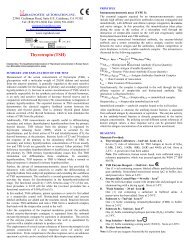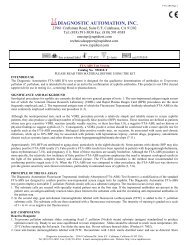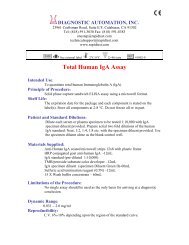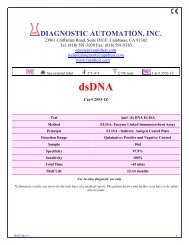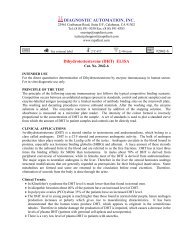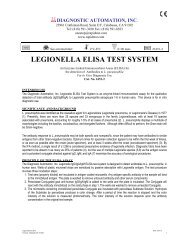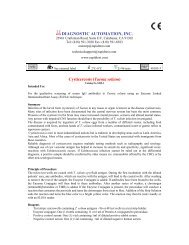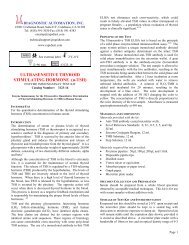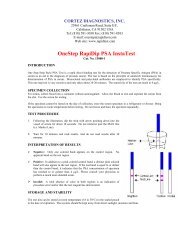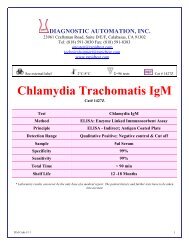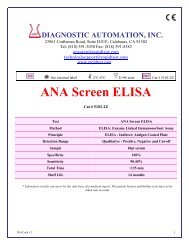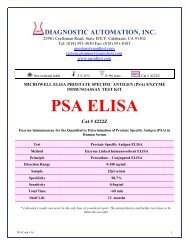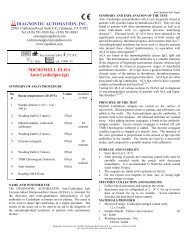OneStep Chlamydia - Diagnostic Automation : Cortez Diagnostics
OneStep Chlamydia - Diagnostic Automation : Cortez Diagnostics
OneStep Chlamydia - Diagnostic Automation : Cortez Diagnostics
You also want an ePaper? Increase the reach of your titles
YUMPU automatically turns print PDFs into web optimized ePapers that Google loves.
PCORTEZ DIAGNOSTICS, INC.23961 Craftsman Road, Suite E/F,Calabasas, CA 91302 USATel: (818) 591-3030 Fax: (818) 591-8383E-mail: onestep@rapidtest.comWeb site: www.rapidtest.com<strong>OneStep</strong> <strong>Chlamydia</strong> TestRAPID IMMUNOCHROMATOGRAPHICASSAY FOR CHLAMYDIA ANTIGENFROM PATIENT SWABSCatalog # 176523F (female testing kit)Catalog # 176523M (male testing kit)InstructionsINTENDED USEThe <strong>Cortez</strong> <strong>Diagnostic</strong>s <strong>OneStep</strong> <strong>Chlamydia</strong> Test is a rapid immunoassay for directqualitative detection of <strong>Chlamydia</strong> trachomatis antigen in endocervical or endourethralswab specimens.SUMMARY AND EXPLANATION OF THE TEST<strong>Chlamydia</strong> trachomatis is one of the most common sexually transmitted pathogens. It is amajor cause of cervicitis, urethritis, endometritis, and pelvic inflammatory disease inwomen. Serious complications can result in salpingitis, infertility, and ectopic pregnancy.If transmitted to infants during birth, chlamydia can cause conjunctivitis and pneumonia.50-70% of infected women are asymptomatic, which makes diagnosis extremelyimportant. 1<strong>Chlamydia</strong> are related to gram-negative bacteria. They are intracellular in nature and areunable to synthesize adenosine triphosphate (ATP). 2 The extracellular elementary bodyform is infectious while the intracellular reticulate form is metabolically active.Epidemiological patterns indicate infections of <strong>Chlamydia</strong> trachomatis parallel or exceedthose of Neisseria gonorrhoeae and the two often occur together. 3 The disease cuts acrossthe socioeconomic spectrum. The primary method for detection of chlamydia is growth ofthe organism in cell culture. Other methods include direct fluorescence assays (DFA),enzyme immunoassays (EIA), and nucleic acid probing. 4,5PRINCIPLE OF THE TESTThe <strong>Cortez</strong> <strong>Diagnostic</strong>s <strong>OneStep</strong> <strong>Chlamydia</strong> Test utilizes the chemical extraction of acarbohydrate antigen from chlamydia followed by the utilization of migratory colorimmunoassay technology for the qualitative detection of <strong>Chlamydia</strong> trachomatis.In the test procedure, a unique set of polyclonal and monoclonal antibodies areemployed. One antibody is immobilized on a porous membrane while the otherantibody is conjugated to dye particles as signaling component. A swab specimenfrom a patient is treated with extraction reagent A and B to extract the antigen. Thetest dipstick is then immersed in the extraction sample. The liquid migrates throughthe absorbent area and along the membrane. If <strong>Chlamydia</strong> trachomatis antigen ispresent, the labeled antibody-dye conjugate binds to it, forming an antibody-antigencomplex. As the mixture flows along the membrane, the complex is captured by theantibody immobilized in the test zone (T) of the membrane, producing a visible rosepinkcolor band. Another dye-conjugated reagent is captured by the antibodyimmobilized in the control zone (C) of the membrane.A rose-pink line in the test zone (T) indicates the presence of <strong>Chlamydia</strong> trachomatisantigen. A rose-pink line in the control zone (C) indicates the test is workingproperly. When only a control line appears with no test line, <strong>Chlamydia</strong> trachomatisantigen has not been detected and the test result is considered negative.The control line gives an added measure of quality control by demonstratingantibody recognition; assuring that the procedure was performed correctly; and thatthe reagents are chemically active. A desiccant is enclosed with the test device tostabilize the reactive agents.REAGENTS AND MATERIALS PROVIDEDNOTE: This test kit does not contain any viable infectious agents.1. Testing Devices. Contains dye-conjugated and immobilizedanti-chlamydial antibody. Sealed individuallyin protective foil pouches. Cat. # 220202. Extraction Buffer A (10.0 ml) 0.05 N Sodium hydroxide solution, in adropper vial. Cat. # 22020A3. Extraction Buffer B (10.0 ml) Tris-HCl buffer pH 9.0 with 0.02% sodiumazide, in a dropper vial. Cat. # 22020B4. Positive Control (1.0 ml) Contains non-infective chlamydial antigenderived from in vitro culture, with 0.1%sodium azide. Cat. # 22020P5. Extraction Tube. Cat. # RXT-0016. Test Instructions Cat. # PI-22020FOR EXPORT ONLY - Not For Sale or Distribution In The U.S.Female Testing Kit Only7. Female Swab, 50 pcs/25 tests. Plastic-shafted sterile Dacron swab fortesting female patients. Cat. # SWA-002Male Testing Kit Only8. Male Swab, 25 pcs/25 tests. Metal-shafted sterile Dacron swab fortesting male patients. Cat. # SWA-001In addition to the materials provided, a watch or timer and test tube rack are also required.STORAGE AND STABILITYAll <strong>Cortez</strong> <strong>Diagnostic</strong>s <strong>OneStep</strong> <strong>Chlamydia</strong> Test reagents (extraction buffers and positivecontrols) should be refrigerated at 2-8°C when not in use. Other test components may bestored at room temperature (15-28°C). Refer to expiration dates for stability.WARNINGS AND PRECAUTIONS1. Wear gloves while handling specimens.2. Dispose of gloves and swabs using good microbiological practices.3. Do not touch the swab tip at any time.4. Wash hands after performing the test.5. Use only the sterile Dacron swabs provided. Swabs from any other sourcemay give faulty results.6. Do not allow a sample swab to come in contact with any reagent bottle tip.Reagent or bacterial contamination will invalidate test performance.7. Do not use the reagents after their expiration dates.SPECIMEN COLLECTION AND PREPARATIONA. Female PatientsTwo sterile Dacron swabs with plastic shafts are required in the female collectionprocedure. One swab is used to prepare the sample site; the other is used for samplecollection.NOTE: Use only the swabs provided with the kit.1. Remove any excess mucus from the potentially infected site with the first swab,then discard it.2. Rub the second swab vigorously over the infected endourethral lining andendocervical cells in the canal wall. 3 As chlamydia are intracellular organisms,firm contact must be made with the canal wall for proper specimen collection.The rubbing action dislodges the endothelial cells and allows the swab toabsorb the bacteria. Improper collection will result in poor visual readings andmay cause invalid results. Vaginal specimens are not useful.B. Male Patient sOne metal-shafted sterile Dacron swab is needed for male penile samplecollection. Do not use a plastic-shafted swab in this procedure.1. Insert the swab into the urethra of the penis. Gently rotate with sufficientpressure to dislodge the epithelial cells. Allow the swab to remain inserted for afew seconds after rotation.2. Carefully remove the swab avoiding contact with any external surfaces.STORAGE AND STABILITYIf a swab is not extracted immediately, store it refrigerated (2°-8°C) for up to 5 days,preferably in a transportation tube. Do not freeze. Swabs may be transported to the test siteunder ambient conditions. Transport media should not be used.TEST PROCEDURENOTE: Read all test instructions before running patient samples or controlsProcedure Notes1. Bring all samples and controls to room temperature (15°-28°C) prior to testing.2. Do not open the foil pouch until ready to perform the test.3. Do not use commercial controls other than those provided with the test as they maycontain additives which interfere with test performance.A. Extraction1. Label an extraction tube for each patient and place in atube holder or rack.2. Add 6 drops of Extraction Buffer A to the extractiontube. Mix liquids by gently swirling the tube. Place thespecimen swab in the tube and twirl briefly to mix thereagent Incubate at room temperature (15°-28°C) for 5minutes, with the swab in the tube.
3. Add 6 drops of Extraction Buffer B to the extractiontube containing the swab.4. Twirl the swab vigorously for 10 seconds, thenexpunge as much liquid as possible from the swab bypressing and rotating the fiber portion against the wallof the tube. Discard the swab. Cap the tube and mixcontents by gentle swirling. The swab extract must betested immediately.B. Immunoassay of the Extract1. Remove the test cassette from its sealed foilpouch by tearing along the notch. Dispense 4drops of liquid from the extraction tube into thesample well ("S") of the test device by invertingand squeezing the tube as shown.2. Read the test results at 15 minutes..IMPORTANT: To avoid incorrect readings or invalid results, do not interpret testresults after more than 15 minutesINTERPRETATION OF RESULTS4. Although the test is very accurate, a low incidence of false results may occur.5. If negative or questionable results are obtained, the test should be repeatedusing a new swab specimen.6. As with all diagnostic tests, a definitive clinical diagnosis should not be basedon the results of a single test, but should only be made by the physician after allclinical and laboratory findings have been evaluated.7. The test only allows for the detection of <strong>Chlamydia</strong> as a presumptive indicationof <strong>Chlamydia</strong> trachomatis infection. However, cases in which patient swabstest negative while the patients' clinical symptoms are indicative of chlamydialinfection should be investigated further.5. For optimal test performance, proper sample collection and storage proceduresare critical.6. PERFORMANCE CHARACTERISTICS7. 1 Specificity and SensitivityAn evaluation of the <strong>Cortez</strong> <strong>Diagnostic</strong>s <strong>OneStep</strong> <strong>Chlamydia</strong> Test kit was run todetermine clinical performance characteristics for the test relative to an available latexone step immunoassay. A total of 110 patients were tested, with two swabs collectedfor each patient. The results of the study were as follows.<strong>Cortez</strong> <strong>Diagnostic</strong>s <strong>OneStep</strong><strong>Chlamydia</strong> Test+ –Latex One StepImmunoassay(37) + 36 1(73) – 3 701. Positive: Two rose-pink bands appear — one in the control zone ("C") and onein the test zone ("T"). The sample should be considered positive for thepresence of <strong>Chlamydia</strong> trachomatis.2. Negative: One rose-pink band appears in the control zone ("C") with noapparent band in the test zone ("T"). The sample should be considered negativefor <strong>Chlamydia</strong> trachomatis.3. Invalid: If no rose-pink band appears in the control zone ("C"), or if a bandappears in the test zone ("T") but not in the control zone, then the test is invalid.It is recommended to retest the specimen using a new Testing Device.Note: There is no meaning attributed to line color intensity or width.QUALITY CONTROLA. Internal Controls:The <strong>Cortez</strong> <strong>Diagnostic</strong>s <strong>OneStep</strong> <strong>Chlamydia</strong> Test contains built-in qualitycontrol features. The development of a rose-pink band in the control zoneindicates that the sample has been absorbed into the device, that capillary flowhas occurred, and that antibody reactivity is at normal level. If the test device isworking properly the background in the reaction area will clear, providing adistinct result.B. External Controls:Good laboratory practice recommends the use of quality controls to ensureproper test performance. A Positive Control containing non-viable <strong>Chlamydia</strong>trachomatis antigen is provided with each kit to verify test performance.Add 4 drops of Extraction Buffer A to an extraction tube. Add one drop ofPositive Control to the tube. Shake the tube to mix the solution well andincubate at room temperature (15°-28°C) for 5 minutes.Add 4 drops of Extraction Buffer B to the tube. Cap the tube and thoroughlymix the contents by gentle swirling.Complete the test according to the procedures described above. A positiveresult is indicated by the appearance of two rose-pink colored lines on themembrane.LIMITATIONS OF THE TEST1. The test is limited to the detection of <strong>Chlamydia</strong> trachomatis in swabspecimens.2. For in vitro diagnostic use only.3. A specimen swab which contains too much blood may cause weak falsepositive results. Therefore, bloody swabs should be avoided.Compared with a latex one step immunoassay for detection of chlamydia from swabspecimens, the <strong>Cortez</strong> <strong>Diagnostic</strong>s <strong>OneStep</strong> <strong>Chlamydia</strong> Test demonstrated a relativesensitivity of 97.2% (36/37). The <strong>Cortez</strong> <strong>Diagnostic</strong>s test also demonstrated a relativespecificity of 95.8% (70/73) and an overall agreement with latex immunoassay of96.3%.2 PrecisionA. Intra-Assay: Within-run precision was determined using the same 3specimens containing negative, borderline positive, and positive values. Thenegative, borderline and positive values were correctly identified in 100% of thetests.B. Inter-Assay: Between-run precision was determined using the same 3specimens of negative, borderline positive control, and positive control of<strong>Chlamydia</strong> antigen in 11 independent assays with 3 different lots of reagentsover a 30-day period. Again, the negative, borderline and positive findings werecorrect in 100% of the tests.3. Cross-ReactivityTo confirm the specificity of the <strong>Cortez</strong> <strong>Diagnostic</strong>s <strong>OneStep</strong> <strong>Chlamydia</strong> Test, 15serotypes were tested and demonstrated to yield <strong>Chlamydia</strong>-positive results. Inaddition, <strong>Chlamydia</strong> psittaci was tested with the <strong>Cortez</strong> <strong>Diagnostic</strong>s test and gavepositive results.Cross-reactivity with other organisms has been studied using suspensions of 10 7CFU/ml (CFU — colony forming unit) and demonstrated to yield <strong>Chlamydia</strong>negativeresults. Staphylococcus aureus was test at 1x10 6 cells/test and also yieldednegative results. The organisms tested are listed below:· Gardnerella vaginalis · Escherichia coli· Klebsiella pneumoniae · Candida albicans· Streptococcus faecalis · Pseudomonas aeruginosa· Neisseria meningitidis · Saccharomyces cerevisiae· Neisseria gonorrhoeae · Proteus vulgaris· Neisseria lactamica · Streptococcus Group B· Neissera meningitidis Streptococcus pneumoniae
BIBLIOGRAPHY1. Schachter, J. "Breaking theChain of <strong>Chlamydia</strong>l Infection," Contemp. Obstet. Gynecol., Vol. 30(1987): 146-159.2. Barnes, R. "Laboratory Diagnosis of Human <strong>Chlamydia</strong>l Infections," Clin. Microbiol. Rev., Vol.2 (1989): 119-136.3. Howard, B. Clinical and Pathenogenic Microbiology (The C.V. Mosby Co.: St. Louis, MO1987).4. Chernesky, M.A. et al. "Detection of <strong>Chlamydia</strong> Trachomatis Antigens by Enzyme Immunoassayand Immunofluorescence in Genital Specimens from Symptomatic and Asymptomatic Men andWomen," J. Infect. Dis., Vol. 154 (1986): 141-148.5. Hipp, S.S., Y. Haun and D. Murphy. "Assessment of Enzyme Immunoassay andImmunofluorescence Tests for Detection of <strong>Chlamydia</strong> Trachomatis," J. Clin. Micriobiol., Vol. 25(1987): 1938-1943.5. Lennette, E. and Schachter J. <strong>Chlamydia</strong>e: Clinical Microbiology Manual, Chapter 85 (AmericanSociety of Microbiology: 1985).CORTEZ DIAGNOSTICS, INC.23961 Craftsman Road, Suite E/F,Calabasas, CA 91302 USATel: (818) 591-3030 Fax: (818) 591-8383ISO 13485-2003Revision Date: 6-5-06



